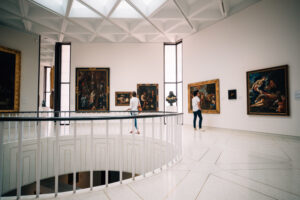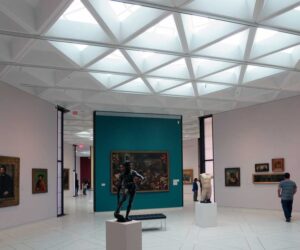The Museo de Arte de Ponce is the largest art museum in the Caribbean and one of the most important in the Americas. Pablo Pérez d’Ors, one of the museums’ past curators noted that the museum is an “important landmark in the construction of an artistic identity for Puerto Rico”. This museum has led museums in the region in the preservation of art and culture during disasters and hurricanes that have become intensified over the years due to climate change. This underscores its role as a cultural leader and model for the resiliency of cultural institutions in the region. The museum remains open as much as possible when offices and schools are closed during natural disasters and when closed it moves its activities to social media.
At HAPPY ART DJ’s highlight the music of Puerto Rico
The Ponce Art Museum has innovated to remain relevant and expose younger patrons to visual art by offering successful music events like HAPPY ART event which was moved to Instagram during COVID. The event featured DJ’s like well-known DJ Mano Santa, who hosted this virtual party featuring Afro-Caribbean, alternative, tropical, funk and disco through the Instagram account of the Museum @museoarteponce. HAPPY ART, Home Edition offered a musical experience created for the public to enjoy from their homes, promoting social interaction at a distance.
Listen to the music of some of the Puerto Rican producers and DJ’s who have played the HAPPY ART event below:
The HAPPY ART event is back in person in the museum’s garden on December 15 after being postponed due to Hurricane Fiona. The retro theme is Y2K and the DJ’s that will be featured are ZTVZ (@_ztvz_) , DJ Galiano (@djgaliano_ ) and DJ EarthToPink (@earthtopink). The event will also have food trucks on hand to feed the partygoers.
The Art of Puerto Rico
Among the visual artists that have been represented in the museum exhibits is the magnificent José Campeche (1751-1809), whose 1988 retrospective at New York’s Metropolitan Museum of Art drew phenomenal praise; the prolific exponents of the 1960s and 1970s era of social and political consciousness such as Rafael Tufiño (the “Painter of the People”), Lorenzo Homar, Antonio Martorell and other masters; and new artists who also celebrate the three races (Caucasian, Black and Native American) that comprise Puerto Rican ethnicity and reflect its strength, beauty and renowned hospitality.

This collection of Puerto Rican works also demonstrates the generosity of the artists and their benefactors. One such patron was Luis A. Ferré (1904-2003), a Puerto Rican MIT-trained engineer, industrialist, philanthropist and Governor of Puerto Rico (1969-1973). He founded Museo de Ponce, located in Ponce, Puerto Rico, his hometown, which opened its doors to the public in 1959. The current building was inaugurated in 1965, designed by U.S. architect Edward Durell Stone, who designed the MOMA in New York and the Kennedy Center in Washington, D.C.
 Today, its collection numbers approximately 4,500 artworks and is recognized worldwide as an important center of European art in America.
Today, its collection numbers approximately 4,500 artworks and is recognized worldwide as an important center of European art in America.
The crown jewel of its Victorian painting is “Flaming June,” by Lord Frederic Leighton (1830-1896). Considered his masterpiece, it was unveiled at the Royal Academy of London in 1895. Leighton pictures a woman in repose, wrapped in a sheer and vibrant orange dress. Her garments envelop her and her posture transforms her into a group of intertwining curves, the Mediterranean Sea with the last rays of sun glimmering behind her.
Deemed “The most wonderful painting in existence” by Samuel Courtauld (1876-1947), it became a relic of the past for the generation scarred by World War I. Three decades later, it literally vanished without a trace. It reappeared in the art market in the decade of 1960 when Victorian art was considered out of fashion. It was rediscovered in a London gallery by Luis A. Ferré, the founder of Museo de Ponce, who fell in love with her at first sight.
A vastly comprehensive archive of outstanding museums housing artworks from around the world may be found at “Collections — Google Arts & Culture,” Included are four museums of Puerto Rico; Museo de Ponce, Museo de Arte de Puerto Rico, Museo de Arte Contemporáneo de Puerto Rico and Instituto de Cultura Puertorriqueña, which are still standing after decades of hurricanes, earthquakes, economic and social turmoil and pandemics.
By Gloria Colon and David Grandison
